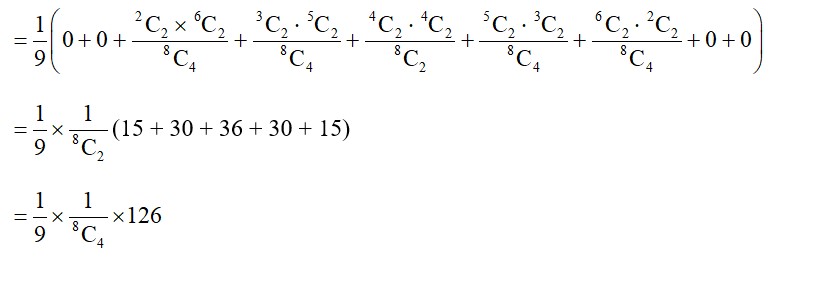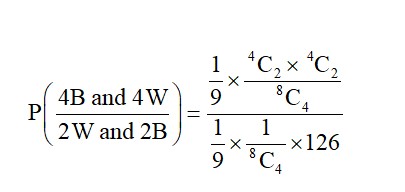52. Find the probability distribution of:
(i) Number of heads in two tosses of a coin.
(ii) Number of tails in the simultaneous tosses of three coins.
(iii) Number of heads in four tosses of a coin.
52. Find the probability distribution of:
(i) Number of heads in two tosses of a coin.
(ii) Number of tails in the simultaneous tosses of three coins.
(iii) Number of heads in four tosses of a coin.
-
1 Answer
-
(i) When one coin is tossed twice, the sample space is
{HH, HT, TH, TT}
Let X represent the number of heads.
∴ X (HH) = 2, X (HT) = 1, X (TH) = 1, X (TT) = 0
Therefore, X can take the value of 0, 1, or 2.
It is known that,
P (HH) = P (HT) = P (TH) = P (TT) = 1/4
P (X = 0) = P (TT) = 1/4
P (X = 1) = P (HT) + P (TH) = 14 + 1/4 = 1/2
P (X = 2) = P (HH) = 1/4
Thus, the required probability distribution is as follows.
X
0
1
2
P (X)
1/4
1/2
1/4
(ii) When three coins are tossed simultaneously, the sample space is {HHH, HHT, HTH, HTT, THH, THT, TTH, TTT}
Let X represent the number of tails.
It can be seen that X can take the value of 0, 1, 2, or 3.
P (X = 0)
...more
Similar Questions for you
P (2 obtained on even numbered toss) = k (let)
P (2) =
P (
If x = 0, y = 6, 7, 8, 9, 10
If x = 1, y = 7, 8, 9, 10
If x = 2, y = 8, 9, 10
If x = 3, y = 9, 10
If x = 4, y = 10
If x = 5, y = no possible value
Total possible ways = (5 + 4 + 3 + 2 + 1) * 2
= 30
Required probability
P (2W and 2B) = P (2B, 6W) × P (2W and 2B)
+ P (3B, 5W) × P (2W and 2B)
+ P (4B, 4W) × P (2W and 2B)
+ P (5B, 3W) × P (2W and 2B)
+ P (6B, 2W) × P (2W and 2B)
(15 + 30 + 36 + 30 + 15)
Let probability of tail is
⇒ Probability of getting head =
∴ Probability of getting 2 heads and 1 tail
ax2 + bx + c = 0
D = b2 – 4ac
D = 0
b2 – 4ac = 0
b2 = 4ac
(i) AC = 1, b = 2 (1, 2, 1) is one way
(ii) AC = 4, b = 4
(iii) AC = 9, b = 6, a = 3, c = 3 is one way
1 + 3 + 1 = 5 way
Required probability =
Taking an Exam? Selecting a College?
Get authentic answers from experts, students and alumni that you won't find anywhere else
Sign Up on ShikshaOn Shiksha, get access to
- 65k Colleges
- 1.2k Exams
- 679k Reviews
- 1800k Answers


